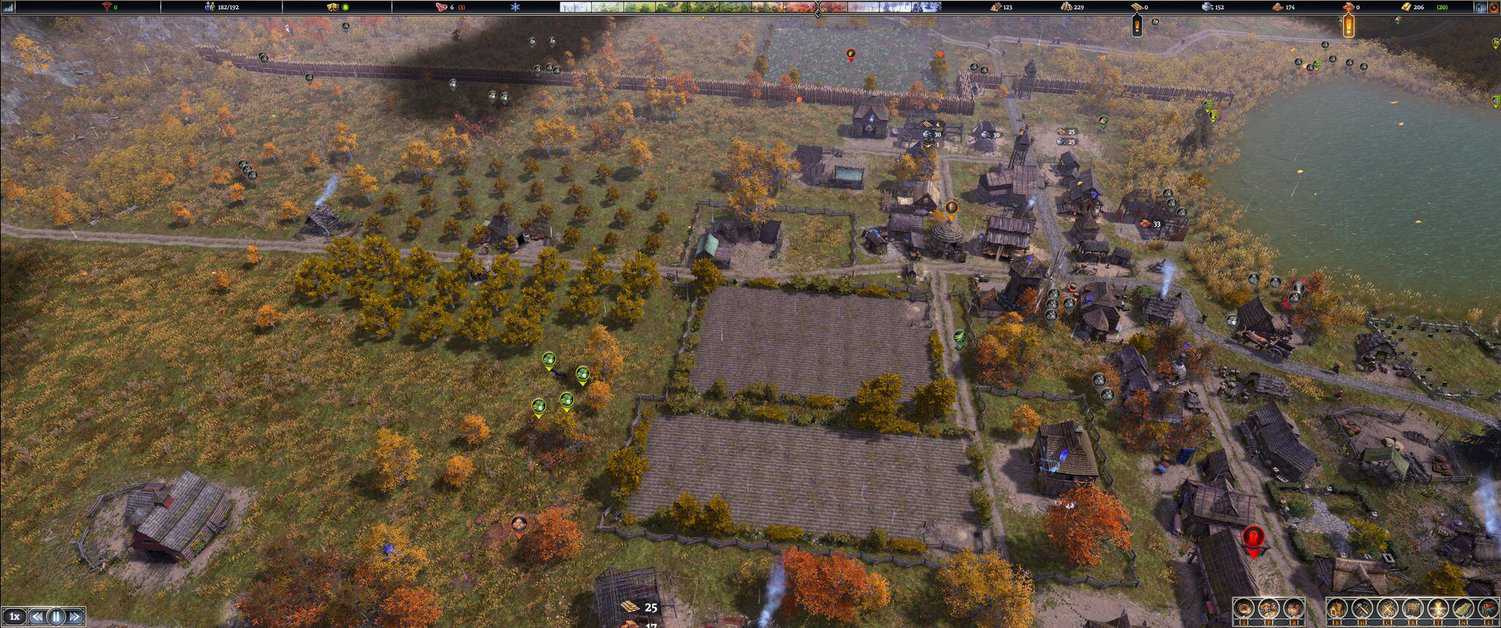Farming in Farthest Frontier is by far the most complex system in the game where you have to worry about yield factors, fertility of the soil, temperature, diseases, and even wildlife trampling on your fields.
Your villagers can hunt game meat, gather berries or perhaps even survive on fruits, but at some point, you will need proper farming fields for your villagers to farm on and ensure your city thrives. You will produce many crops, eventually changing your village into a metropolis with everything available in it.
This guide will break down how to increase the yield of your crops in Farthest Frontier and keep the soil fertile.
How To Create a Farm
The farm creation tool in Farthest Frontier can be found within the food production tab that requires holding and dragging your cursor in the game. Your fields need to be at least 5×5 that can be drawn up to 12×12 on fertile land with high fertility and a balanced soil mixture.
The larger field you will build, the more time it will consume to prepare the field depending on how many laborers you have.
Yield Factor
Before farming the crops, you will need to keep a few things in check as mentioned below
- Crop Yield – How much expected crop can you expect after every harvest
- Weather Tolerance – How well crops can handle the weather
- Rockiness – How well a crop grows in a field with rocks in it
- Weed level – How well a crop grows in a field with weeds in it
- Growth time – How long will it take to grow crops
- Fertility level – How crops affect the fertility
- Fertility Dependance – Good soil means good yield
- Soil Mixture – How much Clay and Sand you require in a Field to even out
Farming in Farthest Frontier
Crop Rotation
In the crop rotation process, you plan out your crop rotation for the upcoming three years by dividing it into three rows, Row 1, Row 2, and Row 3. Keeping an eye on basic stats like fertility, weed level, and rockiness helps you decide what to do with your fields in the upcoming year.
Once you set your three years cycle, it will keep repeating indefinitely until you decide to make any changes to them.
By clicking onto one of the rows you will get multiple crops on the right side with additional stats for the crops and how they are in certain weathers. For example, for a crop that has low heat tolerance, it will not do that great if it’s planted in between summer.
Soil Mixture
Certain crops are great at clay but don’t do that great in the sand. You will also need to keep an eye on the Soul mixture to harvest your crops with a bonus depending on what the crop zones are.
Fertility
However, apart from just planting at some point, you will have to decide to maintain your crops to keep the fertility of the soil good level. Maintaining high fertility is the hardest thing in farming.
There are different ways to improve fertility levels as mentioned below
- To maintain high fertility, grow crops on the different fields each year that will not affect the field.
- Build a Compost yard close to your farm and use your village waste as the fertilizers for your crops. You can add compost to any field once per year.
- Grow crops like clover, beans, and peas once in the rotation to increase the fertility of your soil.
Harvest
You need to keep some time distance when planting crops to separate their harvesting time. If all your fields have similar harvest times, that may cause rot in your fields by not having enough farmers to harvest your crops and ultimately leading to losing the harvest that you have cared for.
Storage
If you have a limited amount of storage, you will need to time your harvest to keep your storage away from filling up. For example, Green leafy vegetables don’t last as long as other vegetables so it’s best to farm other vegetables as well.
Rockiness and Weed Level
When starting on a new field, you will require to do maintenance multiple times to lower its rockiness and weed level. Later into the game, once the rockiness and weed level hit zero, you will only need to do your field maintenance once per rotation.
Protecting Your Fields
Apart from your villagers in the town, there is also wildlife that is hungry for food. To keep them at bay, you will build fences around your fields and add a gate for your farmers to go through to ensure your fields are safe.
You later upgrade them into stonewalls preventing unwelcomed guests from getting into your fields.
The Best Crops to Grow
The best crops that are best for your fertile soil are
Turnips – Grows in a short time so you can have multiple harvests in a single year. It does really well in every weather.
Beans – Improves soil fertility and last longer in storage.
Peas – Improves soil fertility but is weak to heat.
Buckwheat – Buckwheat is a great alternative for wheat. It has a short growth time and can suppress weeds in the soil.
Carrots – Don’t need that much soil fertility to grow and long-lasting in storage. But it doesn’t do that great on rocky fields.
